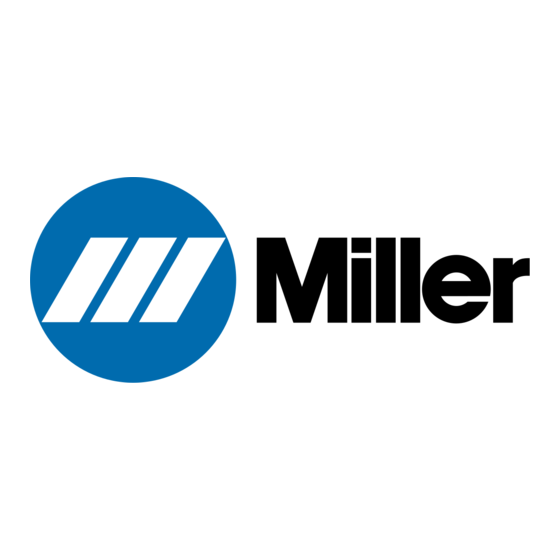Miller Gold Seal 5000 Посібник користувача - Сторінка 7
Переглянути онлайн або завантажити pdf Посібник користувача для Зварювальна система Miller Gold Seal 5000. Miller Gold Seal 5000 48 сторінок.

FUMES
AND
GASES
can
be
hazardous
to
your health.
Welding produces
fumes and gases.
Breathing
these
fumes and gases
can
be hazardous
to
your health.
Keep
your head
out
of the fumes. Do not breath the fumes.
If
inside,
ventilate the
area
and/or
use
exhaust
at
the
arc
to
remove
welding
fumes and gases.
3.
If ventilation is poor,
use an
approved air-supplied respirator.
4.
Read the Material
Safety
Data Sheets
(MSDSs)
and the
manufacturers
instruction for
metals, consumables,
coatings,
and cleaners.
5.
Work in
a
confined space
only
if it is well
ventilated,
or
while
wearing
an
air-supplied respirator. Shielding
gases used for
welding
can
displace
air
causing injury
or
death. Be
sure
the
breathing
air is safe.
6.
Do
not
weld in locations
near
degreasing, cleaning,
or
spraying
operations.
The heat and rays of the
arc can
react
with vapors
to
form
highly
toxic and
irritating
gases.
7.
Do
not
weld
on
coated
metals,
such
as
galvanized,
lead,
or
cadmium
plated
steel,
unless the
coating
is removed from the
weld
area,
the
area
is well
ventilated,
and if
necessary,
while
wearing
an
air-supplied respirator.
The
coatings
and
any
metals
containing
these elements
can
give
off toxic fumes if welded.
Chipping
and
grinding
cause
flying
metal. As welds
cool,
they
can
throw off
slag.
PRINCIPAL SAFETY STANDARDS
Safety
in
Welding
and
Cutting,
ANSI Standard
Z49.1,
from American
Welding Society,
550 N.W. LeJeune
Rd,
Miami FL 33126
Safetyand
Health
Standards,
OSHA 29 CFR
1910,
from
Superintendent
of
Documents,
U.S. Government
Printing
Office,
Washington,
D.C. 20402.
Recommended Safe Practices for the
Preparation
for
Welding
and
Cutting
of Containers That Have Held Hazardous
Substances,
American
Welding
Society
Standard AWS
F4.1,
from American
Welding Society,
550 N.W. LeJeune
Rd, Miami,
FL 33126
National Electrical
Code,
NFPA
Standard
70,
from National Fire Protection
Association,
Batterymarch
Park,
Quincy,
MA 02269.
Safe
Handling
of
Compressed
Gases
in
Cylinders,
CGA
Pamphlet
P-i,
from
Compressed
Gas
Association,
1235 Jefferson Davis
Highway,
Suite
501,
Arlington,
VA 22202.
Code for
Safety
in
Welding
and
Cutting,
CSA Standard
Wi
17.2,
from Canadian Standards
Association,
Standards
Sales,
178 Rexdale
Boulevard,
Rexdale, Ontario,
Canada M9W
1
R3.
Safe Practices For
Occupation
And Educational
Eye
And Face
Protection,
ANSI Standard Z87.
1
,from
American National Standards
Institute,
1430
Broadway,
New
York,
NY 10018.
1.
2.
WELDING
can cause
fire
or
explosion.
5.
Watch for
fire,
and
keep
a
fire
extinguisher nearby.
Sparks
and
spatter
fly
off from the
welding
arc.
The
flying sparks
and
hot
metal,
weld
spatter,
hot
workpiece,
and hot
equipment
can cause
fires and
burns. Accidental
contact
of electrode
orwelding
wire
6.
7.
Be
aware
that
welding
on a
ceiling,
floor, bulkhead,
or
partition
can cause
fire
on
the hidden side.
.
Do
not weld
on
closed
containers
such
as
tanks
or
drums.
to metal
objects
can
cause
sparks, overheating,
or
fire,
8.
Connect work cable
to
the work
as
close
to the
welding
area as
practical
to
prevent
welding
currentfrom
traveling long, possibly
.
1.
Protect
yourself
and others from
flying sparks
and hot metal.
2.
Do not weld where
flying sparks
can
strike flammable material.
9.
unknown
paths
and
causing
electric shock and fire hazards.
Do
not
use
welder
to
thaw frozen
pipes.
3.
Remove all flammables within 35 ft
(10.7 m)
of the
welding
arc.
If
this is not
possible, tightly
cover
them with
approved
covers,
10.
Remove stick electrode from holder
or
cut
off
welding
wire at
contact
tip
when
not in
use.
4.
Be alert that
welding sparks
and hot materials from
welding
can
11.
Wearoil-free
protective garments
such
as
leather
gloves, heavy
easily
go
through
small cracks and
openings
to
adjacent
areas,
shirt,
cuffless trousers,
high
shoes,
and
a
cap.
FLYING SPARKS
AND
HOT METAL
can
cause
injury,
1.
2.
Wear
approved
face shield
or
safety goggles.
Side shields
recommended.
Wear
proper
body protection
to
protect
skin.
CYLINDERS
can
explode
if
damaged.
3.
Keep cylinders
away from any
welding
or
other electrical
circuits.
1.
Shielding
gas
cylinders
contain gas under
high
pressure.
If
damaged,
a
cylinder
can
explode.
Since
gas
cylinders
are
normally
part
of the
welding
process, be
sure
to treat them
carefully.
Protect
compressed
gas
cylinders
from
excessive
heat,
mechanical
shocks,
and
arcs.
4.
5.
6.
7.
Never allow
a
welding
electrode to touch
any
cylinder.
Use
only
correct
shielding
gas
cylinders, regulators,
hoses,
and
fittings designed
for the
specific application;
maintain them and
associated
parts
in
good
condition.
Turn face away from valve outlet when
opening cylinder
valve.
Keep protective
cap in
place
over
valve
except
when
cylinder
is
in
use or
connected for
use.
2.
Install and
secure
cylinders
in
an
upright position by chaining
8.
Read and follow instructions
on
compressed
gas
cylinders,
them to
a
stationary
support
or
equipment cylinder
rack to
associated
equipment,
and
CGA
publication
P-i listed in
Safety
prevent
falling
or
tipping.
Standards.
Cutting
And
Welding
Processes,
NFPA
Standard 51
B,
from National Fire Protection
Association,
Batterymarch
Park,
Quincy,
MA 02269.
